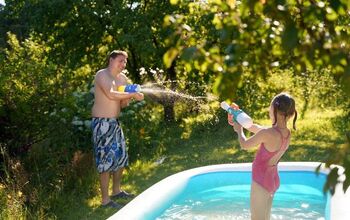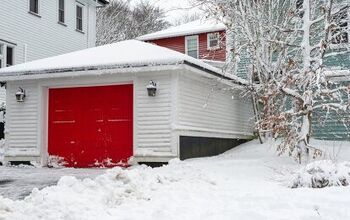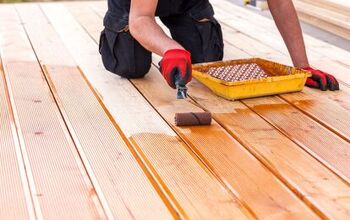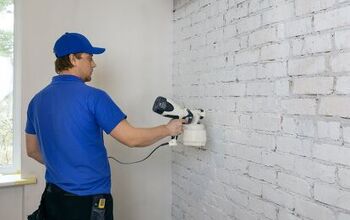Can You Use Interior Paint Outside?

People have their own reasons for why they don’t want to use designated products for a project, such as outdoor paint for an outdoor paint job. Maybe they have too much extra indoor paint, or they don’t want to spend the extra money.
Whatever it is, is it even possible to use indoor paint for outdoor walls?
You can use indoor paint for outdoor walls, however, it won’t last nearly as long and will negate any savings that you experience.
Therefore, it’s best to spend the extra few dollars to get the outdoor paint that can withstand the sun, wind, rain, and other elements.
You can’t just grab any interior paint and slap it on the walls of your porch or patio. There are special exterior paints that you should be using for this purpose.
If you would like to learn more about how to choose the right type of interior paint for outside projects, read on!
Can You Use Interior Paint Outside?
Simply said, interior paint shouldn’t be used outside. The same way that exterior paint is engineered to endure weather changes, inside paint is not.
Interior paint can be vulnerable to the environment, and as a result, it will fade or chip quickly. Additionally, exterior use of interior paints often results in poor adhesion.
Due to their lower viscosity, interior paints tend to be much softer than exterior paints.
The exterior paints’ unique additives are absent from the interior paints. The additions to exterior paints are beneficial due to the following characteristics:
- Water-resistant
- Mildew-resistant
- Dirt-resistant
- Crack- and peel-resistant
- UV protection
The interior paints are designed for surfaces within, not outside. Even though interior paint looks excellent inside a room, exposure to outdoor elements can cause it to chip or fade quickly.
What Happens If You Use Interior Paint Outside?
Paints for indoor surfaces will probably peel and chip if used outside. As interior paint is not designed to resist prolonged exposure outside of a protected indoor setting, you might also notice some fading or discoloration.
The only paint that has been properly labeled for outdoor applications should be used. Choose exterior paint if your external project demands longer-lasting results than interior paints.
If you have inside paint left over from a prior project and are deciding between indoor and outdoor possibilities at your neighborhood hardware shop, it is simple to choose interior paints for outdoor use.
You might as well complete the task if you’re almost done. If it has only recently started, you can paint over it by switching to exterior paint.
Some people advise using an expensive sealant to paint over the interior paint and view the situation as a lesson learned. Instead of spending extra, purchase high-quality exterior paint in the same color and base and add another layer.
What Do You Do If The Interior Paint Used Outdoors Begins To Deteriorate?
It’s time to remedy the problem if interior paint was inadvertently utilized outdoors and you now see chipping or fading. There will need to be the removal of the aforementioned interior paint.
It’s crucial to avoid attempting to touch up interior paint outside because the freshly applied coat of inside paint will continue to deteriorate in the weather.
You may address the interior paint concerns by doing the three straightforward actions shown below:
- Sand the area. Sand any sections that are cracking or look unsightly to make sure it’s a nice, smooth surface.
- Prime it up. Use exterior paint primer to prepare the surface.
- Paint. Repaint the region with exterior-grade paint. After removing the interior paint and priming the area with external primer, you will need to repaint the area with premium exterior paint.
What Are The Differences Between Interior and Exterior Paints?
You can always use the same shade of interior paint combined into an outside formula if you’re truly in love with it. Interior paints have a disadvantage when applied to outside surfaces due to the absence of several compounds that are specialized to that environment, but the distinction between interior and exterior-formulated paints goes further.
Pigment
When you examine a paint’s other three fundamental elements — pigment, binders, and liquids — differences also start to show up. Let’s start with the substance that gives a paint can its color: pigment.
External paint formulae avoid these pigments, extending the duration between exterior painting operations.
Interior paints may contain chemical pigments for color, and some of these pigments are known to substantially fade when used on an exterior surface.
Similarly to this, binders, which are used to cement the pigment together and promote adherence to the painted surface, are added to paint formulations.
Exterior paints require extra assistance to counteract the negative impacts of the environment, so outdoor-friendly paint formulations utilize binders to give the paint resilience to integrity issues like cracking and chalking as well as improved moisture control.
Instead, interior paint binders might provide superior abrasion resistance, which isn’t always a property that exterior paint needs.
Types Of Liquid Added
There are significant differences between interior and exterior paints in terms of the liquids employed.
Federal regulations state that interior paints, specifically indoor water-based paints like latex, are made to have the fewest amounts of volatile organic compounds (VOCs).
VOCs vaporize at room temperature and are utilized as solvents in the liquid portion of paint.
Both short-term and long-term health issues are associated with VOCs, from headaches and lightheadedness (short-term) through lung disease and liver damage (long-term). They might also be linked to particular malignancies.
According to the EPA, indoor VOC levels can range from two to five times greater than outside levels, and they can rise dramatically after painting.
Try to find interior paints with little to no VOC content. It’s crucial to keep in mind that you should never use exterior paint inside your home because not all exterior paints comply with the same low-to-no VOC criteria as paints made for internal use (particularly oil-based paints).
And there is another choice—paint designed to be used both inside and outside—for people who don’t understand why this must be so challenging. A hybrid paint with formulas for the interior and exterior does exist.
Can I Use Inside Paint To Cover Exterior Paint?
Exterior paint is not the same as interior paint. The goods for indoor or outdoor use have been improved by modern chemistry and technology.
The short answer is yes, but the longer one is, why would you want to use indoor paint that won’t withstand the weather?
If applying water-based interior paint over oil-based exterior paint, surface preparation and the application of a primer is necessary.
It is important to remember that if the paint is exposed to the environment, it won’t tolerate temperature variations, humidity, UV rays, mildew, or other weather variables, as well as exterior paints.
While it might initially be cheaper to use inside paint rather than external paint, it won’t last as long, and you’ll have to apply another coat sooner, negating any savings.
It also raises the labor component. You can easily paint over exterior paint with interior paint if a repair or addition turned an exterior wall into an interior wall. However, outdoor usage of interior paint is not advised and frequently voids any warranty.
Will Interior Paint Wash Off Outside?
Although interior paint can be used outside, it is not advised because the paint will deteriorate and fade much more quickly.
Interior paint is easily washable or brittle when exposed to the outdoors. Interior paint should not be utilized outside due to these reasons.
What Is The Best Paint For Outside House Walls?
Pliolite masonry paints may withstand cold or rainy conditions significantly better than conventional water-based external masonry paint. As a result, they are the ideal masonry paint option for painting outside walls in cold or wet weather.
How Long Will Interior Latex Paint Last Outside?
Water-based latex paint is a versatile paint that may be applied to interior or outdoor projects.
Latex paint has fewer toxins than oil-based paint because it is primarily composed of water but is considerably more prone to freezing. Latex paint can last between two and ten years if stored properly.
What Is The Best Paint For Exteriors?
There are two main categories of paint: water-based and oil-based. Because oil-based paint contains alkyd, which is better for handling temperature changes, humidity, and dirt resistance, it is preferable for outside painting.
Oil-based paints are ideal for exterior painting since they are particularly designed with ingredients that give them endurance.
Related Guides:

Heather is a passionate writer who loves anything DIY. Growing up, she learned everything from home repairs to design, and wants to share her tips with you. When she's not writing, she's usually hiking or searching for her next DIY project.
More by Heather Robbins



























